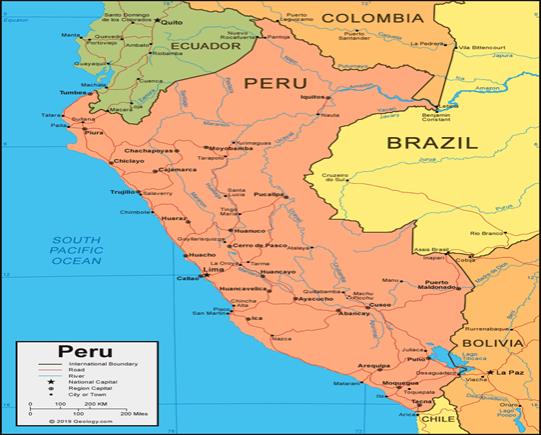Trade Balance
In 2019, the trade balance was U.S.$6.6 billion and accumulated four consecutive years of commercial surplus despite a reduction in the terms of trade exchange.
Total exports decreased 2.8% from U.S.$49.1 billion in 2018 to U.S.$47.7 billion in 2019 due to lower prices of exports of traditional mining products, especially zinc and copper, and lower volume exports of petroleum. Non-traditional exports increased 5.7% in 2019, particularly agricultural crops and fishing. Total imports slightly decreased 1.9% from U.S.$41.9 billion in 2018 to U.S.$41.1 billion in 2019, which reflected primarily lower prices and reduced consumption of industrial products.
Peru maintains close commercial ties with the United States, and China. From 2015 to 2019, exports to the United States and China averaged 11.9% and 28.3% of total exports, respectively, while imports from these countries averaged 20.6% and 24.2%, respectively. The transactions with these countries represented 42.3% of total trade completed in 2019. In addition, trade with Canada, Argentina, Chile and Brazil was meaningfully increased.
In January 2012, Peru and Venezuela signed a Partial Scope Trade Agreement. In June 2012, Peru, Colombia, Chile and Mexico signed a framework agreement with the Pacific Alliance trade bloc. On January 7, 2012, Peru, Bolivia and Venezuela entered into a Partial Scope Trade Agreement; however, this agreement has not yet entered into force.
In March 2012, the Economic Partnership Agreement executed in May 2011 by Peru and Japan entered into force. Likewise, in July 2012 the Free Trade Agreement with the Kingdom of Norway entered into force, as part of the Free Trade Agreement between Peru and the European Free Trade Association (EFTA). The main products exported to the EFTA states are: gold, fish oil, copper, fishery and agricultural products, asparagus, textiles and avocado. Switzerland is the main destination of these products.
In March 2013, a delegation of Peruvian officials was invited to India in order to initiate negotiations of a free trade agreement. On November 28, 2014, Peru and Turkey completed the second round of negotiations for the Peru-Turkey free trade agreement. On May 29, 2015, Peru signed a free trade agreement with Honduras in Lima.
On February 4, 2016, ministers of the 12 nation-members of the Trans-Pacific Partnership (TPP) attended a signing ceremony in Auckland, New Zealand. On April 29, 2016, Peru and Brazil executed the Agreement for Economic and Commercial Development. On January 1, 2017, Peru and Honduras initiated the formal approval process for the free trade agreement signed by the two sovereigns in May 2015. And in March 2017, a delegation from Peru held a technical meeting in New Delhi, India to agree on the terms of reference for negotiation of a trade agreement between Peru and India.
The Comprehensive and Progressive Agreement for Trans-Pacific Partnership (CPTPP) was executed in Santiago, Chile on March 8, 2018. The agreement is subject to an internal ratification process and therefore has not yet entered into force in Peru.
On February 12, 2019, the Minister of Trade and Tourism, Eduardo Ferreyros, and the Australian Minister for Trade, Tourism, and Investment, Steven Ciobo, signed a new trade deal in Canberra, Australia. The Free Trade Agreement with Australia which was effective as of February 11, 2020 is one of the most ambitious bilateral trade agreements Peru has ratified. This agreement includes a particular commitment relating to small- and medium-enterprises, as well as on development, competitiveness and reducing bureaucracy to facilitate business formation.
President Kuczynski’s administration sought to align Peru with other countries by reducing trade barriers and simplifying the procedures that regulate the flow of productive factors, in order to optimize the utilization of scarce resources. Following the resignation of President Kuczynski, President Martin Vizcarra has maintained the same policies.
Peru classifies its non-free trade zone exports as traditional and non-traditional exports. Traditional exports consist of goods that historically have constituted a greater share of Peru’s exports and include mostly raw materials. Non-traditional exports include goods that historically have not been exported in significant quantities and traditional export goods that have been transformed through manufacturing or other processing.
D-76
